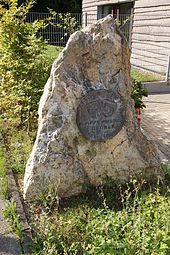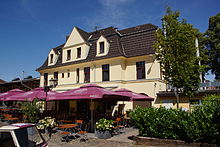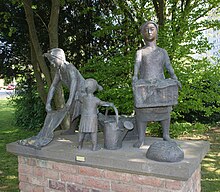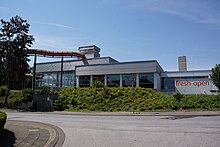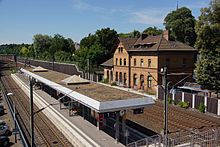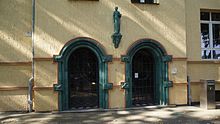Cheeky
| coat of arms | Germany map | |
|---|---|---|

|
Coordinates: 50 ° 55 ' N , 6 ° 49' E |
|
| Basic data | ||
| State : | North Rhine-Westphalia | |
| Administrative region : | Cologne | |
| Circle : | Rhein-Erft district | |
| Height : | 75 m above sea level NHN | |
| Area : | 45.11 km 2 | |
| Residents: | 52,439 (Dec 31, 2019) | |
| Population density : | 1163 inhabitants per km 2 | |
| Postal code : | 50226 | |
| Area code : | 02234 | |
| License plate : | BM | |
| Community key : | 05 3 62 024 | |
| LOCODE : | DE FRN | |
| City structure: | 9 districts | |
City administration address : |
Johann-Schmitz-Platz 1–3 50226 Frechen |
|
| Website : | ||
| Mayoress : | Susanne Stupp ( CDU ) | |
| Location of the city of Frechen in the Rhein-Erft district | ||
Frechen is a town in the Rhenish lignite district in the Rhein-Erft district and borders Cologne in North Rhine-Westphalia to the west .
geography
location
The original settlement center of Frechen is an elongated street village on the northeast slope of the Ville on both sides of the Frechener Bach , which formerly rises in Benzelrath and which flowed along the main road and previously seeped into the gravel of the Cologne Bay . Today it is only recognizable as a drain from the sewage treatment plant and now flows into the Cologne Rand Canal . The place used to be divided into an upper village and a lower village down the slope. The border was at the Frechener Burg (Burgstrasse), whose trenches were also fed by the stream. After lignite mining ended and the land was recultivated , Frechen took part in the Rhineland Nature Park , which also included the Königsdorf Forest, which was not affected by mining.
Districts
Frechen consists of the following districts: (1)
| District | Residents |
|---|---|
| Cheeky downtown | 22,891 |
| Königsdorf (with Neufreimersdorf and Neubuschbell) | 11,592 |
| Bachem (with Neuhemmerich) | 5,386 |
| Habbelrath | 3,621 |
| Bushbell | 2,945 |
| Pit Carl | 2,028 |
| Huckle | 1,446 |
| Grefrath | 1,358 |
| Benzelrath | 1,226 |
| total | 52,493 |
In Frechen, a separate form of the dialect spoken in the western area around Cologne emerged , which was the normal colloquial language of the residents of Frechen until the middle of the 20th century, but has since lost a lot of ground.
history
Ancient and Middle Ages
Quartz sand was quarried in Frechen as early as late antiquity and was used for glass production.
The place name, in the oral tradition Freichem , can be interpreted as a place with the sloping -heim ending, which is typical for the Franconian conquest . The defining prefix free cannot be interpreted. One possibility is the meaning of Frei (old German fri) as Fried, maybe even in the meaning of enclosed = fenced. The first church in Frechen can be assumed between 726 and 800. A certificate does not exist. In the year 877 the first written mention with the Latinized name Frekena is in a document of Emperor Charles the Bald , at this time the settlement was described as belonging to the Kölngau . On September 9, 941 Archbishop Wichfrid awarded the Cäcilienkloster in Cologne real estate in Frechen (Cäcilienhof, later also called Weierhof). In 955 the Roman Catholic parish church of St. Audomar received relics of St. Audomar .
In the privilege granted by King Otto IV to Archbishop Adolph in 1204, the customs of Frechen, which had been wrongly moved there some time before, were lifted again to the advantage of the Cologne Church. In 1217 Archbishop Engelbert I of Cologne confirmed the transfer of goods to Frechen by Gerberga, the abbess of St. Maria in the Capitol, to the Cistercians in the Kamp monastery . In 1230 the bailiwick of Frechen was given to Count Wilhelm von Jülich as a fief .
In a dispute between Archbishop Konrad I and the city of Cologne in 1256, Cologne residents laid the village of Frechen in ashes. In 1435 Heynrich Huyn von Merckelbach was mayor and bailiff of the glory Frechen. In 1461 Leenhart von Merckelbach took over both offices after the death of his father.
Modern times
Between 1500 and 1650 Frechen master potters created the Bartmann mug out of Frechen stoneware . The jugs from Frechen became world famous and are now also in museums in Amsterdam, Paris, London, Cambridge and even in Florida, USA. In 1540 there was the first Protestant Reformed parish in Frechen .
In 1700 lignite mining began. In 1750, 1,300 inhabitants lived in Frechen, 320 in Bachem and 450 in Buschbell. On October 6, 1794, Frechen was occupied by French revolutionary troops from the Hatry division of the Armée de Sambre-et-Meuse . Subsequently, Frechen became a Mairie (mayor's office) of the canton of Weiden . In 1800 there were 74 Jews in 16 families, seven of whom had moved here in the last third of the 18th century. In 1815 Frechen became a Prussian mayor's office together with Bachem and Buschbell , which existed until March 1927. In 1857 the parish church of St. Audomar was rebuilt according to a design by the Cologne cathedral builder Ernst Friedrich Zwirner .
In 1862, Albert Meier founded Frechen's first stoneware pipe factory on Breite Straße. From 1864, further stoneware tube factories were founded, including Adolph Bauer also in Breiten Straße 24, which was closed in 1901, in 1867 Simon Lövenich & Co. in Hauptstraße 17/19, in 1874 Johann Schaaf on the corner of Klosterstraße and Alte Straße, in 1879 Lövenich & Hendrickx in Josefstrasse and Alten Strasse, 1883 Weiden & Schaaf on Kölner Strasse, 1885 H. & J. Geusgen on Kölner Strasse, 1886 Gerhard Dorn in Blindgasse and Alten Strasse, 1887 Conzen & Co. on Kölner Strasse, in 1889 Jacob Kalscheuer & Co. on Kölner Strasse and in 1895 that of Andreas Lövenich on Josefstrasse. In 1884 industrial quartz sand mining began. On August 18, 1891, the first lignite and briquette factory ( Sibylla ) was founded. The first electric street lighting existed in 1893 . In 1894 the Cöln-Frechen small railway was opened and the first waterworks was put into operation. In 1898, the Kleinsorg & Lövenich stoneware tube factory was re-established on the site of the abandoned factory of Johann Schaaf .
There have been street names in the city since 1900. On December 1 of the same year, according to the census, there were 6028 inhabitants in Frechen, 1320 in Bachem and 686 in Buschbell. On August 18, 1901, the Wachtberg I brown coal works u. Briquette factory, Frechen GmbH founded. In 1903 the stoneware pipe factory Balkhausen & Co. was founded on Hubert-Prott-Strasse and the stoneware pipe factory Tillmann Vogt on Dürener Strasse. In 1904 the Cöln-Frechener Christallsandwerke GmbH was founded by August Lindemann. In 1905 the stoneware tube factory Cremer & Breuer was founded on Kölner Straße and in 1906 Rhenania on Dürener Straße. In 1907 the lignite works and briquette factory Grube Carl (Beller Hammer) were founded. On September 21, 1913, the St. Severin Church was consecrated.
In the First World War from 1914 to 1918 314 soldiers fell from the mayoralty Frechen. Between 1921 and 1933, Frechen was a stronghold of the Communist Party of Germany (KPD) in the Cologne region. In the 1924 Reichstag election, the number of SPD votes fell from 33.8% (1920) to 12% (1924). The KPD received 29% for the first time; After the municipal council election in May 1924, ten of the 18 council members belonged to the German Center Party , three to the Social Democratic Party of Germany (SPD) and five to the KPD. The following persons represented the KPD in the municipal council in 1926: Jakob Schlösser, Johann Bürger, Elisabeth Schiefer, Christian Utzerath and Fritz Heidbüchel. In 1924 the company Quarzmahlwerk Frechen GmbH was founded with the managing director Otto Lindemann. In 1925 Toni Ooms and Franz Albermann started with the Frechen art, building and series ceramics. From May 1925 to January 1936, the OB Dennert publishing house published the Frechener Tageblatt three times a week . In 1926 social housing began to be built.
On March 2, 1927, the municipalities of Bachem and Buschbell were incorporated with the approval of the Prussian State Ministry on February 14, 1927. On August 22, the new municipality received a coat of arms . In 1931 the first independent New Apostolic congregation existed in Frechen.
During the National Socialist era , the Jewish community ended in 1938. On April 1, 1940, a middle school was opened, which was later converted into a secondary school. On March 4, 1945, after a short battle with a German rearguard, US troops occupied the place and installed Josef Kleinsorg as Lord Mayor of Frechen. During the Second World War , over 500 Wehrmacht members from the Frechen community died.
On February 25, 1948, an artillery shell from the Second World War exploded in the green areas of the playground of the then Lindenschule (Protestant elementary school, today's music school). Three students died in the accident; 14 others were injured, some seriously. After the census on September 13, 1950, the population rose to 20,490 citizens. In 1951 Frechen received city rights with 21,417 residents . In 1954, 404 residents from Benzelrath were relocated to the outskirts of Frechen because of lignite mining: The place was dredged in 1956 together with Benzelrath Castle . In 1958 a town partnership was entered into with the town of Kapfenberg in the Austrian state of Styria . According to the census on June 6, 1961, the population was 26,613. In the election for the city council on March 19, there were 18,237 eligible voters and a voter turnout of 81.93%. Of the 30 seats, the SPD won 15, the CDU 13 and the FDP two seats. In the election for the city council on September 27, 1964 with 18,953 eligible voters and a turnout of 80.99%, the SPD received 19 seats and the CDU 12 seats. In 1966 the population was 30,409 after the update.
In 1972 Frechen became the regular start and finish point of the classic Cologne-Schuld-Frechen cycling route. On January 1, 1975, the Cologne district became part of the Erftkreis . Parts of the previous municipalities Türnich (Grefrath and Habbelrath), Lövenich (Königsdorf) and Brauweiler (Neufreimersdorf) were incorporated. In 1998 the city marketing company was founded. In 2011 the city of Frechen passed the 50,000-inhabitant mark; the number has been corrected to just under 50,000 since the 2011 census.
politics
City council
The city council is the municipal representative body of the city of Frechen. The citizens decide on the composition every five years. The last election took place on May 25, 2014.
mayor
- since 2015: Susanne Stupp (CDU)
- 1999–2015: Hans-Willi Meier (CDU)
- 1988–1999: Jürgen Schaufuss (SPD) (full-time since 1996)
- 1972–1988: Kurt Bornhoff (SPD)
- 1961–1972: Johann Schmitz (SPD)
- 1958–1961: Kurt Bornhoff (SPD)
- November 5, 1948 to 1958: Johann Schmitz (SPD)
- September 25, 1946 to November 4, 1948: Bernhard Kohlbecher
- June 1945 to September 24, 1946: Josef Kleinsorg (as Lord Mayor)
- March 28, 1943 to March 3, 1945: Konrad Volm (NSDAP)
- June 1, 1942 to March 28, 1943: Mayor's post not filled
- July 22, 1933 to June 1, 1942: Walter Küper (NSDAP, acting)
- June 1, 1933 to July 22, 1933: Mayor's post not filled
- August 1, 1925 to June 1, 1933: Peter Toll
- 1895–1925: Alphons Keimes
- 1866–1895: Anton Franz
- 1835–1866: Johann Josef Kügelgen
- 1831–1835: Christian Uhles
- 1818–1831: Caspar Josef Müller
- 1814-1818: Henrich Fischer
- 1802–1814: Caspar Josef Müller
- until 1802: Johann Wolff
Municipal director (head of the municipal administration)
- April 1, 1947: Hans Schaeven
- September 25, 1946 to March 31, 1947: Josef Kleinsorg
badges and flags
- coat of arms
| Blazon : "The coat of arms of Frechen shows a black, red armored and tongued Jülich lion in the golden field, holding a brown beard man mug in its paws." | |
| Justification for the coat of arms: Frechen was granted the right to use a coat of arms in a certificate from the Prussian State Ministry of August 22, 1928. The design comes from the heraldist Arnold Steiger from Cologne. He took over the coat of arms of the dukes of Jülich , who were the sovereigns for most of the municipality for many centuries. As a special ingredient, he chose the symbol of old Frechen craftsmanship, the Bartmann mug , which he gave the Jülich lion in the paws. |
- flag
- As a banner and as a hoisted flag : "The flag of the city of Frechen shows the colors black and gold."
Town twinning
A town partnership with Kapfenberg in Austria has existed since June 13, 1956 . There are annual trips from both sides. The fire brigades in both cities are particularly committed. For example, a delegation from the Kapfenberg Volunteer Fire Brigade was welcomed to World Youth Day 2005 . She supported the fire brigade on the Marienfeld . In 2006 the 50th anniversary of the partnership was celebrated with festivals in both cities, where people also visited each other. The last visit came from Kapfenberg in June 2006, which began with a celebration in the town hall. At the time, the Frechen Music School provided entertainment with the support of iGaming Frechen.
economy
Originally influenced by the natural resources of lignite (→ Frechen opencast mine and the last briquette Wachtberg , today coal refining plant Frechen of RWE Power ), quartz sand ( quartz movements group ) and tone , has Frechen since the 1970s to a city of trade , the traffic - of communications and services . Because of the traffic-good location right on the motorway intersection Cologne-West is settled Logistics - Companies in Frechen. The central warehouse of Porta Möbel, the wholesale company Lekkerland and various forwarding agents such as DPD Germany , not far from the Cologne mail distribution center of Deutsche Post . There is a connection to the companies, which are mostly located in the new industrial park on Europa-Allee (EuroPark), and an optimal surrounding structure in terms of settlement geography , as well as proximity to the airport and the Cologne Eifeltor transshipment station .
After the Second World War, there were twelve stoneware factories in Frechen. In 1995 three more were added. The world's only clay pipes with a clear width of up to 1400 mm were manufactured in Frechen until around 1995 . Due to falling demand, production was stopped and the factory buildings demolished. Furthermore, since April 2010 the largest DIY store in Europe with 30,000 m² of sales area, a Bauhaus branch , has been located in the village . Since the end of the 20th century, other companies from the fields of industry, trade and services have also settled in Frechen.
Culture
The pottery town of Frechen, with a Bartmann mug in its coat of arms, is advertised nationwide through changing exhibitions in an avant-garde hall, the Keramion (center for modern and historical ceramics). The craft pottery of the region is presented in full. The building erected in 1971 by Peter Neufert takes up the motif of a potter's wheel.
At the annual Frechen pottery market, artists from all over Germany and in some cases from neighboring countries offer everyday and art ceramics for sale.
Furthermore, the German International Graphics Triennale , which was initially launched as a biennial in 1970, takes place in Frechen - organized by the Frechen Art Association in cooperation with the city of Frechen.
In addition to the art association, the Frechen history association is the largest culture-bearing association in the city. He publishes a yearbook with articles on the history of Frechen and its districts and offers numerous lectures, excursions, exhibitions and study trips. Since 2009, the association has been laying stumbling blocks to commemorate 53 victims of National Socialism. In project work, he deals with the history of the nobility in Frechen before 1800 and the history of the Frechen and Bachemer Bach; Since 2007 there has been a monument sponsorship for a ground monument complex consisting of two pottery kilns from the 17th and 19th centuries. Together with the Pulheim History Association , the association has compiled more than 20,000 death notes in the Rhein-Erft death notes collection.
The city archive, which was set up in 2001, set up a “room for city history” in May 2014 with the support of many volunteers and its support association, which presents permanent and temporary exhibitions. The research of the city archive on the history of the Jews in Frechen and their fate is integrated as a permanent exhibition.
The Harlequin theater ensemble, founded in 1979, has a firm place in the ambitious amateur theater scene. Three to four premieres are offered annually in a separate venue ( Haus am Bahndamm ), plus there are improvisational theater and theater for children as well as numerous guest performances.
The Linden Theater , which has existed since 1957 and is now a listed building, is the only remaining cinema in Frechen. In the 1960s there were five. The movie theater is operated by two support associations: The non-profit association Frechen-Film e. V. has been showing an arthouse program every Wednesday since 1990, with the support of the city, the association Linden-Theater e. V. has been the sponsor and operator of the cinema leased from him since 1995. Even this work with current films cannot be done without volunteer work. In addition, the annual rock-against-HIV benefit concert traditionally organized by SV Frechen for the benefit of AIDS-Hilfe Köln e. V. instead. Local up-and-coming bands such as 5vor12 , the Huntershreds , BlueShift and many others - but also nationally known bands and artists such as Peilomat or Ricky Garcia , guitarist from LaFee - were on stage for a good cause. Traditionally, the annual concert of the Frechen mandolin orchestra 1926/31 takes place on Sunday of the Dead in Frechen.
The Husky Linz private collection showed Indian exhibits such as clothing, everyday objects, weapons, tents and covered wagons. It was one of the largest of its kind in Europe.
In the old signal workshop at the former station of the Cologne-Frechen-Benzelrath railway , around 20 studios of regionally known artists have found a home since 2010/11, including that of the Stolpersteine artist Gunter Demnig , who also lives there. The association for culture, movement and encounter, Line 7 e. V. tries to expand the public image of the city through campaigns like “Play The Parkhaus” or “Der Rote Faden”. Centrally located in the city is the main street traversed by tram line 7 , where there are many retail shops.
The outdoor terrace pool is very well known in Frechen. It consists of three pools and a diving platform and is located in the Frechen city center district.
Museums
See: List of museums in the Rhein-Erft district
Religious communities

- Evangelical parish with churches in Frechen city center, Bachem and Königsdorf
- Catholic Church in Frechen: The eight Catholic parishes work together in a parish community - Heilig Geist (Bachem), St. Audomar (city center), St. Antonius of Padua (Habbelrath), St. Mary's Assumption (Grefrath), St. Maria Königin ( City center), St. Sebastianus (Königsdorf), St. Severin (city center), St. Ulrich (Buschbell / Hüüllen)
- Muslim prayer room
- New Apostolic Congregation
Attractions
- The old rectory next to the St. Audomar church : The preserved part of the old churchyard is the oldest secular building in the city. Until 1553 it belonged to the monks and canons of Saint-Omer (in German: Audomar).
- The neo-Romanesque Roman Catholic Church of St. Audomar , built 1849–1859 (tower 1909) according to plans by Cologne cathedral builder Ernst Friedrich Zwirner , renovated in 1960 and 2002 (vaults and interior painting), organ from 2005 ( Klais organ building , Bonn; predecessor buildings from the center 8th century).
- The building of the Protestant church dates back to 1716. The last of a series of extensions and renovations was carried out in 1971. Inside there are several works of art from the 18th century.
- The Jewish cemetery from 1752 to 1930 on Dr.-Schultz-Strasse with 84 gravestones
- Numerous houses of a very early social housing (from 1925), often decorated with Frechen building ceramics. for example Keimesstraße, Freiheitsring, Hubert-Prott-Straße (Bachem: "red block")
- a variety of ceramic figures and ornaments on Frechener houses, ceramic fountains in the pedestrian zone of the main street.
- A number of sculptures and groups of sculptures related to the local pottery and lignite mining, but also depictions of daily housework and professional work, as well as depictions of children by Olaf Höhnen, are distributed across the city .
- The linden theater from 1957 (see above)
- The Keramion from 1971 shows permanent and changing exhibitions of modern ceramics and houses the Frechen Ceramic Museum (see above). It was designed by the architect Peter Neufert .
- Haus Bitz in Bachem is a moated castle, which was supplemented by a modern new building by Oswald Mathias Ungers.
- The listed old town hall
Technical architectural monuments:
- The first station building of the Cologne-Frechen-Benzelrath Railway from 1894 is still clearly recognizable today, despite several extensions from 1911 and later.
- The former central depot of the Cologne-Frechen-Benzelrath Railway existed from 1894 to 1982. Today only the ring locomotive halls , which are grouped around a former turntable, and a number of locomotive sheds can be seen. All halls are now used by retail stores. The open hall gates that have been retained suggest railway operations.
- The underground elevated tank on the Wachtbergrand (1893) and the water tower (1906) next to it have been repaired in modern forms. Today they are used as fancy apartments.
- The factory halls of the Grube Carl briquette factory have been converted into loft apartments.
- The slide of the indoor swimming pool, which was renovated in 1984, was the longest in Europe at 91 meters when it opened.
education
In Frechen there are six primary schools, the secondary school of the city of Frechen, the grammar school of the city of Frechen and the secondary school Herbertskaul as secondary schools as well as a special school and an art school. There is also a vocational college in this city.
traffic
Road traffic
Frechen is to the motorway A 1 connected via the junction cheeky south of the motorway interchange Köln-West. Another partial junction with the name Frechen Nord was built on Bonnstrasse for the A 4 , but is only one-sided, i. H. for traffic to and from Aachen, usable. A connection to and from Cologne is being planned. The former main traffic axis, the Kölner Straße, is a pedestrian zone in the city center, through which only line 7 of the Cologne tram runs. The development traffic continues from Dürener / Kölner Straße as Landesstraße 277 and from Frechen train station north around the city center. The regional traffic is diverted as federal highway 264 south around the core city.
Local public transport
Frechen is connected to Cologne by line 7 ( Zündorf - Porz Markt - Heumarkt - Neumarkt - Rudolfplatz - Aachener Str. / Gürtel - Frechen-Benzelrath ) of the Cologne urban railway . In the urban area of Frechen there are the stations '' Frechen-Benzelrath '', '' Mühlengasse '', '' Frechen Rathaus '', '' Frechen Kirche '' and '' Frechen Bahnhof ''. There is also an S-Bahn station in the Königsdorf district , where the S13 ( Düren - Horrem - Weiden West - Ehrenfeld - Hansaring - Köln Hbf - Cologne / Bonn Airport - Troisdorf ) and S19 (Düren - Horrem - Weiden) lines West - Ehrenfeld - Hansaring - Cologne Central Station - Cologne / Bonn Airport - Troisdorf - Siegburg / Bonn - Au (Sieg) ) stop the S-Bahn Cologne, in rush hour the S12 ( Horrem - Weiden West - Ehrenfeld - Hansaring - Cologne Hbf - Porz - Troisdorf - Siegburg / Bonn - Au (Sieg)).
The Rhein-Erft-Verkehrsgesellschaft (REVG) also operates eight bus routes in Frechen, most of which are of both local and regional importance. Exceptions to this are the school bus routes 957 and 968 as well as the bus route 931, they only run in the Frechen area. The central transfer point in Frechen is the '' Frechen Rathaus '' bus station, here is also a REVG customer center .
The number 145 bus runs through Frechen, which, like the trams in Cologne, is operated by the Cologne transport company (KVB) . It connects Frechen with the Cologne districts of Weiden , Lövenich , Widdersdorf and Bocklemünd / Mengenich . At the stops `` Weiden Zentrum '' and `` Bocklemünd '' there is a transition to the tram and at the stop `` Bf Lövenich '' back to the S-Bahn lines S12, S13 and S19.
Personalities
Honorary citizen
- Hubert Prott (* 1853, † May 7, 1932), Graflich Fürstenberg chief forester; Hubert-Prott-Strasse is named after him
- 1958: Werner Erkens († 1959), clergyman, chaplain to St. Audomar , parish rector of St. Severin 1914–1923, pastor to St. Severin 1923–1945
- 1972: Johann Schmitz, first mayor of the city of Frechen 1948–1958 and 1961–1972
- 1976: Gottfried Cremer (born October 3, 1906, † October 15, 2005), founder of the Keramion in Frechen, managing partner of many ceramic companies in Frechen, Bavaria and Baden-Württemberg .
- 1981: Paul R. Kraemer (born May 13, 1916, † May 10, 2007), goldsmith, entrepreneur ( Kraemer Group ) and patron ( Gold Kraemer Foundation ). A street and a path were named after him and his wife around the headquarters of the foundation.
- 1988: Kurt Bornhoff († October 10, 1999), Mayor of the city of Frechen 1958–1961 and 1972–1988
- 1991: Heinrich Wolf , heir to brickworks and stoneware factory, home builder (born January 20, 1926, † July 22, 2010)
sons and daughters of the town
- Carl Baumann (1868–1939), politician (center), member of the Reichstag.
- Heinrich Loevenich (1896–1965), Nazi functionary, 1933–1945, District Administrator of the Cologne District
- Josef Köllen (1903–1965), politician (CDU), member of the state parliament of North Rhine-Westphalia
- Toni Schmücker (1921–1996), industry manager
- Josef Schmitz-Helbig (1921–2008), architect
- Karl Lambertin (born April 23, 1936), football player
- Gerhard Schauff (1938–1996), Brazil missionary
- Johannes Ruland (1939–2020), entrepreneur, manager, board member
- Marion Schneider (born May 16, 1945), author, lecturer, tour guide
- Rolf Michels (born October 1, 1952), book author
- Hardy Fuß (born May 5, 1955), politician and member of the state parliament of North Rhine-Westphalia
- Michael Reschke (born September 29, 1957), football official
- Eva Schumann (* 1957), author
- Paul Berf (born November 23, 1963), translator
- Heino Falcke (* 1966), radio astronomer
- Rainald Grebe (born April 14, 1971), cabaret artist
- Mirco Wallraf (born December 12, 1974), actor
- Kirsten Bolm (born March 4, 1975), track and field athlete
- Wayne Carpendale (born March 23, 1977), actor and presenter
- Jan Rouven (born July 8, 1977), magician
- Björn Otto (born October 16, 1977), pole vaulter
- Pierre Vogel (born July 20, 1978), Islamist preacher and former boxer
- Ayọ (born September 14, 1980; Joy Olasunmibo Ogunmakin ), soul singer
- Dana Bönisch (born June 4, 1982), writer
- Jennifer Breitrück (born April 30, 1982), actress
- DJ Pierre (born February 21, 1984; Pierre Hirsch de Hesselle), hit DJ
- Sonja Bertram (born September 14, 1984), actress
- Marcel Heller (born February 12, 1986), football player
- Dennis Erdmann (born November 22, 1990), football player
- Jan Hojer (born February 9, 1992), sport and competition climber
- Lennart Thy (born February 25, 1992), football player
Personalities who have worked on site
- Franz Albermann (1877–1959) was an art sculptor and relief artist who worked initially from Cologne and later from Frechen .
- Karlheinz Gierden (* 1926), politician (CDU) lives in Frechen.
- Ernst Huberty (* 1927), sports journalist and television presenter, lives in Frechen.
- Peter Kühnst (* 1946), sports scientist, lives in Frechen.
- Gunter Demnig (* 1947), artist and publisher of the “ Stolpersteine ” has his studio in the Signalwerk art center in Frechen.
literature
- Landschaftsverband Rheinland, Office for Rhenish Regional Studies, Bonn (Ed.): Rheinischer Städteatlas , Delivery IV No. 22,1978 Frechen. Bonn 1978, ISBN 3-7927-0436-6 .
- Paul Clemen: The art monuments of the Rhine province. The district of Cologne. Düsseldorf 1897, reprint Düsseldorf 1983, ISBN 3-590-32118-0 :
- Bachem pp. 9-13, 130-132.
- (Alt-) Benzelrath pp. 14-15, 132-134.
- Buschbell pp. 111-113.
- Frechen (“Inner City”) pp. 123–128.
- Hüelte pp. 146–147.
- Königsdorf (Groß-Königsdorf) pp. 140–144.
- Königsdorf (Klein-Königsdorf) p. 159.
- Vorst House pp. 129–128.
- Johann Köllen, Hans Kinsky, Robert Steimel: seals and coats of arms, castles and palaces in the Cologne district. Robert Steimel-Verlag, Cologne 1966:
- Bachem pp. 64-68, 130-132.
- (Alt-) Benzelrath pp. 69-70.
- Buschbell pp. 70, 134 f.
- Frechen (“Inner City”) pp. 58–61, 122–128.
- Karl Göbels: Frechen - at that time, from Roman times to becoming a town. Cologne 1977, ISBN 3-7927-0326-2 .
- Karl Göbels, City of Frechen (Hrsg.): Coat of arms of Frechen - A contribution to Rhenish heraldry and genealogy. 1966.
- Karl Göbels: The history of the parish church St. Audomar in Frechen. Frechen 1960 (printed as a manuscript on behalf of the city of Frechen).
- Egon Heeg: Frechener streets - a mirror of Frechen's history . Volume I downtown (Frechen). Cologne 1984, ISBN 3-7927-0822-1 .
- Egon Heeg: The Cologne-Frechener ceramics 1919–1934. Cologne 1992, ISBN 3-7927-1284-9 .
- Egon Heeg: 100 years of the Frechen electricity and waterworks. Bruehl 1995.
- Egon Heeg: The Levys or the annihilation of ancient Frechen Judaism. Cologne 2010, ISBN 978-3-927312-97-5 .
- Hafen und Güterverkehr Köln AG (Ed.): 100 years Cologne-Frechen-Benzelrath Railway. Cologne 1993.
- Helmut Weingarten: The railway between the Rhine and Erft . Cologne 1987, ISBN 3-7927-0973-2 , p. 21-29, 65-69 .
- Festschrift of the city of Frechen. On the occasion of the city elevation on September 2, 1951. Der Löwe Cologne, Cologne 1951.
- The City Director of the City of Frechen, Dept. Public Relations (Ed.): Frechen, a city changes its face, 1951–1991 documentation of city views. Hahne-Schloemer-Verlag, Düren 1992.
- Uwe Schreiner Ed .: Frechen, a cityscape , Rathaus-Buchhandlung Greuel + Schreiner, Frechen 1990
- Wolfgang Reinert: The Beatus Chronicle , Edition Octopus in the publishing house Monstein and Vannedat, Münster 2013, ISBN 978-3-86991-840-2
Web links
- City of Frechen
- Frechener Geschichtsverein (main article there under Frechen )
- University of Greifswald: reduced old measuring table sheets digitized (sheet 5006 from 1895)
Individual evidence
- ↑ Population of the municipalities of North Rhine-Westphalia on December 31, 2019 - update of the population based on the census of May 9, 2011. State Office for Information and Technology North Rhine-Westphalia (IT.NRW), accessed on June 17, 2020 . ( Help on this )
- ^ Rudolf Niemann: Individual images from the history of the city of Frechen, Frechener Burg in the online presence of the Frechener Geschichtsverein , accessed in February 2009
- ^ City administration Frechen Department 1.10 - Control support
- ↑ Mackensen Deutsche Etymologie, 1977 p. 308
- ^ Crane Point Museum located in the Florida Keys offers historical information, nature tours, marine-life exhibits. In: www.cranepoint.net. Retrieved October 11, 2016 .
- ^ Günter Bers: A regional structure of the KPD: The Middle Rhine district and its party congresses in the years 1927/1929, Einhorn Presse Verlag, 1981, ISBN 3-88756-021-3 , pp. 136-137
- ↑ Franz-Joseph Kiegelmann: Crime Scene stoneware kiln: the Frechener Communists; Resistance, persecution and judicial processes; Documents and analyzes, Frechener Geschichtsverein 2008, ISBN 978-3-00-025291-4 , 80 pages
- ^ Archives of the Protestant parish of Frechen
- ^ Federal Statistical Office (ed.): Historical municipality directory for the Federal Republic of Germany. Name, border and key number changes in municipalities, counties and administrative districts from May 27, 1970 to December 31, 1982 . W. Kohlhammer, Stuttgart / Mainz 1983, ISBN 3-17-003263-1 , p. 301 .
- ↑ Manfred Funken: Census - With too many citizens expected. In: Rhein-Erft Rundschau. May 31, 2013, accessed May 9, 2016 .
- ^ City of Frechen. Council election - overall result. May 25, 2014, accessed April 25, 2015 .
- ↑ Coat of arms of the city of Frechen. Retrieved December 30, 2012 .
- ^ Main statute of the city of Frechen, § 2 (coat of arms, flag, seal). City of Frechen, accessed on January 20, 2020 .
- ↑ Madsack, Mayerhofer, Plück: 150 Years of Frechener Steinzeug Industrie, Frechen, 2002.
- ↑ "The largest hardware store in Europe" , Kabel eins , broadcast "Adventure Life - Daily Knowledge" from June 15, 2010
- ^ Room at stadtarchiv-frechen.de ( Memento from July 14, 2014 in the Internet Archive )
- ↑ Bernd Rosenbaum: Indian - “Husky” Linz had to leave its reservation in Buschbell. In: Rhein-Erft Rundschau. May 8, 2016, Retrieved May 9, 2016 .
- ↑ Actions . On: linie7-frechen.de
- ↑ Hauptstr., Frechen city map - meinestadt.de. Retrieved October 8, 2019 .
- ↑ The parish association became a parish community. ( Memento from July 18, 2012 in the web archive archive.today )
- ↑ Uta Böker: The Church of St. Audomar in Frechen was consecrated 150 years ago , in Kölner Stadtanzeiger, Rhein-Erft, on September 9, 2009, p. 31
- ↑ Kölner Stadtanzeiger, December 31, 1984
- ↑ Stadt Frechen, Ed .: Lebendiges Frechen, magazine of the city of Frechen, December 1990 issue, p. 16
- ↑ Realschule website , accessed on December 5, 2019







